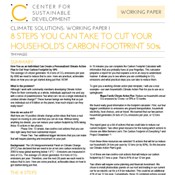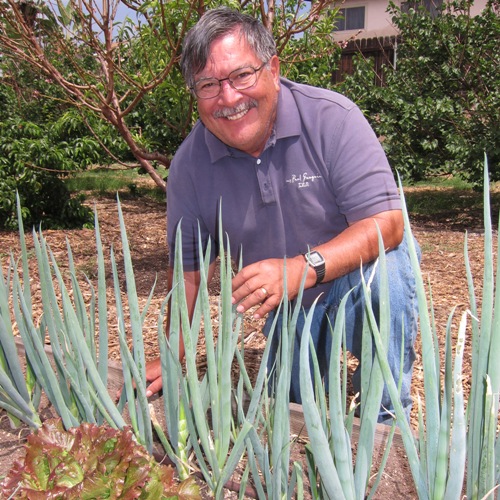Your Carbon Footprint: 8 Steps to Cut Your CO2 Emissions by 50%
The IPCC Report has declared that we need to be at NET ZERO carbon emissions by 2050 to keep global warming below 1.5°C.
How Can You Prevent Climate Change? Step 1. Run a Carbon Footprint Calculator on Your Household.
The average US citizen generates 16.4 tons of CO2 emissions per year.
Here are practical, achievable ideas on how to reduce your carbon footprint by 50%.
Download PDF: 8 Steps You Can Take To Cut Your Household’s Carbon Footprint 50% .
TIM MAGEE
8 STEPS YOU CAN TAKE TO CUT YOUR HOUSEHOLD’S CARBON FOOTPRINT 50%
SUMMARY
How You as an Individual Can Create a Personalized Climate Action Plan to Cut Your Carbon Footprint by 50%
The average US citizen generates 16.4 tons of greenhouse gas emissions in one year. By 2050 we need to reduce that to zero. Here are practical, achievable ideas on how you can get started in your households doing just that: NOW!
What is the problem?
Although I work with community members developing Climate Action Plans for their community as a whole, individuals approach me and say with a sense of powerlessness “but what can I do as a single individual to combat climate change?” These human beings are feeling that as just one individual out of 8 billion on the planet, how much impact can they really have?
How do we solve it?
Well here are 15 positive climate change action ideas that have a real impact on moving to net zero and that you can do now. Without doing anything too drastic, you can reduce your carbon footprint by 50% taking these 15 actions in two phases.
- Phase One: 13 simple, low-cost/no-cost actions that you can take right away that have substantial impact.
- Phase Two: Two additional bigger decisions that you can make that will require planning and investment on your part.
Background:
The UN Intergovernmental Panel on Climate Change Report (IPCC Report) has declared that we need to be at net zero carbon emissions by 2050 to keep global warming below 1.5°C 1. What are greenhouse gases? GHG emissions are measured in tons of CO2. The average US citizen generates 16.4 tons of CO2 emissions per year. How to stop climate change? Therefore, over the next 28 years we each need to reduce that to net zero. Here are some practical, achievable ideas on how to get started doing just that.
THE 8 STEPS
PHASE ONE: SIMPLE THINGS THAT YOU CAN DO RIGHT AWAY THAT HAVE REAL IMPACT.
Step One.
How to stop global warming:Write a Climate Action Plan to reduce your carbon footprint by 50%. This is very important to do if you want success.
The first thing to do in developing your Climate Action Plan is to perform a carbon footprint calculation on your household. Much like an ecological footprint calculator, I used this great Quick Carbon Footprint Calculator 2 from the University of California, Berkeley.
In 15 minutes you can complete the Carbon Footprint Calculator with information that you probably have at your fingertips. Calculate! This calculator prepares a report for you that explains a lot in an easy-to-understand estimate. It allows you to calculate where you are contributing to CO2 emissions and what practical steps you can take to reduce them.
To give you a working climate action plan template, I will use a real example—our own household’s Climate Action Plan for you to use as a springboard:
Write Indigenous Climate Action Plans
8 Week Class
Hands On
How to Write a Climate Action Plan
8 Week Class
Hands On
Fund Your Climate Action Plan
8 Week Class
Hands On
Launch Your Climate Action Plan
8 Week Class
Hands On
Manage Your Climate Action Plan
8 Week Class
Hands On
Intl. Community Based Adaptation
Monthly
Subscribe Now!
Breaking News: Climate Solutions
Monthly
Subscribe Now!
Magee Family Climate Action Plan: Reduce our household’s annual CO2 emissions by 12 tons—or 50% in 12 months.
We found really good information in the footprint calculator. First, our four biggest contributors to GHG emissions are ground transportation, household electrical energy, food choices, and air travel.
We learned that our two-person household generates 24 tons of CO2 emissions per year, or 12 tons each.
The report gave us a list of actions that we could take to reduce our current footprint. Two other great resources for fine tuning which actions to choose are Mike Berners-Lee’s book The Carbon Footprint of Everything 9 and Project Downturn 10.
From these three resources we selected 15 actions that will let us reduce our household’s 24 tons per year by 12 tons (or by 50%). So this became our Climate Action Plan’s goal.
13 of these are low-cost/no-cost actions that will reduce our carbon footprint by 9.7 tons a year. That is 81% of our 12 ton goal.
Two others will require some planning and financial investment. Solar electricity for home: We chose to install photovoltaic panels (rooftop solar power—we could have chosen a home wind turbine) for home energy needs, and trading in our current car for an electric car for a 4.9 ton reduction. This could be an additional 41% of our 12 ton goal. Cumulatively, these 15 combined actions exceed our 12 ton goal, so we have some flexibility.
I highly recommend the Carbon Footprint Calculator. I learned where we are generating carbon emissions, what inexpensive actions we can take to reduce our carbon footprint now, and what more expensive actions could be phased in. In one or two years we can indeed reduce our carbon footprint by 50%.
Step Two:
Have climate conversations to leverage and multiply our results and successes with friends, family, and colleagues.
Set an example: Become influencers! We will share with people early on about our climate action plan. We might only be two individuals out of the whole planet, but if we can share what we’re doing with 10 family members and friends—we could start a snowball effect.
We’re part of a WhatsApp family group. Every month as we take one positive step, we can let them know that we’ve done it, how we did it, how much it cost, and what the impact will be. Maybe our friends and family have in the back of their minds doing something like this too—but aren’t sure how to do it—or if it will have a meaningful impact. We can show them: step-by-step.
Become Activists: Speak to a local nonprofit working in climate change. Speak to your local City Council members. You may find that they are already working on a climate action plan and that you could learn from that process. They might also learn from your climate action plan too!
Step Three.
Travel. Reduce carbon footprint by 2 tons per year: 17% of our 12-ton goal.
Plan vacations or business trips in order to cut one round-trip flight per year. This will save us 2 tons of carbon emissions per year. According to the Emissions Calculator from the German nonprofit Atmosfair 3, flying from London to New York and back generates about 1,320kg of CO2 per passenger. That’s over one ton per passenger per round-trip flight. That’s a lot.
My wife and I have traditionally taken three international trips per year. Some for work, and some for vacations. So we looked at our plans and realized that we could tack a vacation trip onto the end of a business trip and save one round-trip flight. We won’t lose any of the pleasures of vacation time away, but we will drop 2 tons of CO2 out of our normal annual travel emissions, and begin cutting our ties to fossil fuels.
Step three doesn’t take any time or financial investment. It’s just a simple decision to save two tons of CO2. An added plus is that it will meaning a travel savings of $2,000 per year.
Step Four.
Meat. Reduce carbon footprint by 1.6 tons per year: 13% of our 12 ton goal.
Cut our animal protein consumption in half. According to the World Resources Institute (WRI), this will reduce our carbon footprint by 1.6 tons per year 4. Cattle are the world’s third-largest emitter of greenhouse gases, after China and the US.
Plus, we need to face the music anyway. Our physician has been telling us to lose some weight and to reduce our consumption of saturated fats, cholesterol, and salt for years. Now is our chance.
Americans eat over a half of a pound of meat (beef, pork and poultry) per day 11. So how do we cut that in half? Eat less meat, more produce: If we did nothing more than begin incorporating guidelines from flexitarian or Mediterranean diets 12, 13 into our weekly meals, we would be well on our way to cutting our animal protein by more than one-half without reducing the enjoyment of our delicious meals. We might even find that we will begin to lose a little weight, lower our blood pressure and that our doctor will begin smiling at us again!
Step Five.
Food Waste: Reduce carbon footprint by 1.8 tons per year: 15% of our 12 ton goal.
Reduce food waste in our home. One-third of all food produced is either lost in the farm-to-market production and sales process, or simply thrown away by consumers. This amounts to 1 billion tons of food each year, which accounts for 10 per-cent of global greenhouse gas emissions 5. The FAO study, Food Wastage Footprint & Climate Change 6, states that the per capita carbon footprint of food wastage for North Americans is 0.9 tons per year: This means 1.8 tons for our 2 person household.
The problem falls into two categories:
2) Making meals that are way too big and so we wind up throwing away the leftovers.
There’s an old adage for dieters that we can use too: go to the grocery store with a list and stick to it. Don’t be tempted by things that you either shouldn’t eat or don’t need. Planning healthier meals and writing shopping lists in Step 4 can help us avoid food waste by not over buying food.
Subtotal: We have now achieved a 45% reduction of our 12 ton goal. During these first five steps we’re not actually spending additional money.
Step Six.
Good Habits: Reduce carbon footprint by 4.3 tons per year. 36% of our 12 ton goal
These are seven additional low-cost actions don’t require much time or money, but they require developing good habits. Here they are:
Maintain our vehicle (tune-ups and tire pressure)
Practice “eco driving” (takin’ it easy) to save gas
Ride a bike, walk or use public transport for errands to save more gas
Telecommute to work (working virtually or remotely)
Turn off lights
Switch to LED lights to save electricity
Wash laundry in cold water, hang dry (no dryer)
Total:
0.5 Tons
0.7 Tons
0.5 Tons
1.0 Tons
0.1 Tons
0.6 Tons
0.9 Tons 8
4.3 Tons per year
Here are three options:
Keep our new electric car but drive it 50% less:
Eat less meat: Reduce our animal protein consumption to 25%:
Purchase green electricity:
Total:
1.2 Tons
0.8 Tons
2.8 Tons 8
4.8 Tons per: 100% of our goal!
We’re already enjoying this! We can reduce our carbon footprint to 2.3 tons per person in our household before 2030, still retain lifestyle pleasures, and tackle climate change in our own household.
Subtotal: We have now achieved 81% of our 12 ton goal in Phase One. With the exception of maintaining the car and the LEDs, these are no-cost items.
PHASE TWO: THINGS THAT WE CAN DO THAT WILL REQUIRE SOME PLANNING AND SOME INVESTMENT ON OUR PART.
Now we enter into an area of greater expense and planning. If we like, we can elect to take one of the following two actions per year over two years.
Step Seven.
Reduce carbon footprint by 2.1 tons per year. 17% of our 12 ton goal.
Step Eight.
Reduce carbon footprint by 2.8 tons per year. 23% of our 12 ton goal.
Grand Total: We have now reduced our carbon footprint by 14.6 tons thereby surpassing our 12 ton goal reduction by 22%! Our new household carbon footprint is 9.4 tons per year, down from 24 tons.
BONUS:
Three ideas to reduce the remaining 9.4 tons of our carbon footprint:
Now, since we completed our initial 50% carbon footprint reduction plan, I’m going to add a third phase for the future: Actions that may be more drastic but will allow us to begin chipping away at the 9.4 tons remaining of our two person footprint.
Background: Although the IPCC report is recommending net zero emissions by 2050, a limit on GHG emissions would need to be set at a global average of 2.3 tons per capita of CO2 per year by 2030 7. That would mean a total footprint of 4.6 tons per year for our two-person household. So here are some additional ideas.
PHASE THREE: STEPS THAT MAY BE MORE DRASTIC BUT WILL ALLOW US TO WORK ON THE NEXT 50% OF OUR FOOTPRINT.
Since our two-person carbon footprint was reduced to 9.4 tons per year, we need to reduce it another 4.8 tons to get down to 4.6 tons per year for our household by 2030.
Would you like to learn more about developing Climate Change Action Plans? How to Write A Community Climate Change Action Plan.

Real human help: Tim Magee is an internationally recognized climate scientist, researcher, mentor, and trainer with over 12 years of experience in designing climate change action plans. Mr. Magee is CSDi’s Executive Director, and the author of A Field Guide to Community Based Adaptation, Routledge, Oxford, England.
Mr. Magee is available for 1) live workshops with you and your group to develop your Climate Action Plan or 2) to consult with you on your Climate Action Plan. Contact us here for more information.
Over 15 years, Mr. Magee has worked with 5,000 training participants from nonprofits and NGOs in 154 countries on a wide range of projects and programs about people, the environment, and climate change. He has a background in renewable energy and wrote a pioneering book on passive solar energy for heating homes.
Join 15,000 individuals, and members of nonprofits and local governments:
References:
1. The evidence is clear: the time for action is now.
2. The CoolClimate Network Quick Carbon Footprint Calculator from the University of California, Berkeley.
3. Atmosfair
4. WRI. World Resources Institute. Shifting Diets For A Sustainable Food Future Infographic
5. UNEP: Food Wastage Index Report 2021
6. Food Waste Footprint & Climate Change. FAO
7. Carbon inequality in 2030. Per capita consumption emissions and the 1.5⁰C goal. Oxfam
8. The climate mitigation gap: education and government recommendations miss the most effective individual actions
Seth Wynes and Kimberly A Nicholas, Lund University
9. The Carbon Footprint of Everything, by Mike Berners-Lee.
10. Project Drawdown Table of Solutions
Drawdown Lift report and factsheet: Climate–Poverty Connections
11. National Chicken Council.12. Climate-friendly diets can make a huge difference. Amanda Schupak
13. Analysis and valuation of the health and climate change cobenefits of dietary change
DOWNLOAD PDF:
8 STEPS YOU CAN TAKE TO CUT YOUR HOUSEHOLD’S CARBON FOOTPRINT 50%
Copyright © Tim Magee
CLIMATE COURSES & WORKSHOPS
Our cutting-edge training programs will work perfectly for creating a Local Climate Action Plan for your community.
CONSULT WITH TIM MAGEE ON CLIMATE ACTION
Mr. Magee is available to consult with you or your group in developing your Climate Action Plan. Contact us for information.
CONTACT US WITH CLIMATE QUESTIONS
Let us help you with individual questions—and your group’s climate planning, training and consulting needs.
CLIMATE SOLUTIONS: BREAKING NEWS FOR POSITIVE CHANGE!
Join 15,000 community members, and members local governments and nonprofits: Subscribe to
Climate Solutions.











